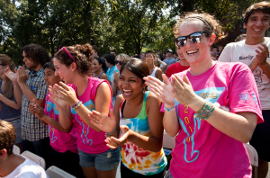To the Head of the Class
By Helene Ragovin
The incoming freshmen represent the face of Tufts: smart and diverse

The Class of 2014, which includes students from 45 states and 35 countries, at matriculation. Photo: Winslow Martin
Tufts’ Class of 2014 made its debut Wednesday afternoon, filing onto the academic quad for matriculation exercises in the sweltering heat.
The arrival of the 1,315 first-year students in the schools of Arts and Sciences and Engineering offers both a window on the university’s future and a nod to its past. With stellar scholastic scores and significant diversity—racial, ethnic, socioeconomic and geographic—the class represents the face of Tufts for the 21st century.
The university received 15,432 applications for the undergraduate class, the second-largest pool ever, and accepted 24 percent, the most selective year since 2001, said Lee Coffin, dean of undergraduate admissions. The School of Engineering saw a record number of applications for the fourth year in a row.
The Class of ’14 has an academic profile similar to the class that precedes it: the mean SAT scores are 705 for critical reading, 712 for math and 714 for writing. Engineering students set a record for math scores with a mean of 752. Eighty-five percent of the students graduated in the top 10 percent of their high school class.
The percentage of students receiving financial aid has increased: 38 percent will be receiving need-based grants, up from 35 percent last year. “Due to the recession, we anticipated that families who might not have applied for financial aid a year or two ago would be applying now, and that has clearly been the case,” said Coffin. The number of students receiving federal Pell grants is 131.
Eleven percent are among the first generation in their families to go to college. “We’ve been tracking that for four years, and, personally, that’s something I really care about,” Coffin said. “It’s an important hallmark of Tufts.”
Throughout the economic roller coaster of the past two years, Tufts has maintained a consistent level of socioeconomic diversity, Coffin noted. “Against real constraints, we have preserved our core value on that important score.”
The percentage of domestic students of color in the Class of ’14 is 26 percent, up from 24 percent in the previous class.

The entering class includes 70 valedictorians and 37 National Merit Scholars. Photo: Alonso Nichols
Eight percent of the students come from abroad, a number comparable to previous classes, Coffin said. In addition, the Class of ’14 has expanded the number of students from Africa, the result of international recruitment efforts introduced last year. Incoming freshmen hail from South Africa, Kenya, Tanzania, Nigeria, Ghana and Mauritius. The largest number of international students come from China, South Korea and India; overall, 35 nations are represented.
Closer to home, there are more first-year students from Massachusetts than any other state. A record number of Californians, more than 10 percent, is also represented in the class. The students graduated from 886 high schools in 45 states as well as Washington, D.C., Puerto Rico and the U.S. Virgin Islands. They include 70 valedictorians and 37 National Merit Scholars.
The relative calmness of the admissions cycle—in contrast to the uncertainties that rattled college admissions nationwide during the start of the financial crisis—marked a return to a more typical Tufts experience.
“If I had to create a storyline for this year, it’s the stability of Tufts in the external economic moment,” Coffin said. “There could have been a variety of outcomes this year, but Tufts, like many places, had a restoration to normalcy.
“The admissions cycle of ’08–’09 was most acutely affected by the economic downturn, and we had anticipated another year like that. But as we moved through the ’09–’10 cycle, it was eerily normal,” Coffin said. “All of the indices that we track were back to ’07–’08 levels: the number of potential students visiting, number of applications, the demographic profile. It turned out to be a very normal year.”
Helene Ragovin can be reached at helene.ragovin@tufts.edu.
